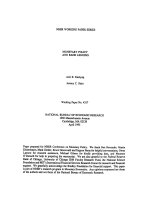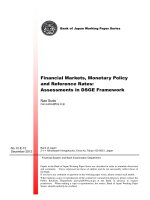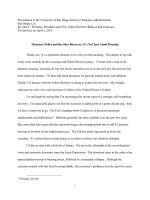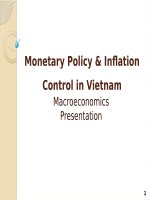Macroeconomics Presentation Topic: Monetary Policy and Inflation Control in Vietnam
Bạn đang xem bản rút gọn của tài liệu. Xem và tải ngay bản đầy đủ của tài liệu tại đây (1.78 MB, 24 trang )
Monetary Policy & Inflation Control in Vietnam
Macroeconomics Presentation
1
Content
I. Overview
1. Monetary Policy of VN
2. Inflation of VN
II. Tools of State Bank of Vietnam
III. How Vietnam used Monetary Policy to control Inflation
2
I. Overview
1. Monetary policy of Viet Nam
1.1 Legal framework:
Based on the SBV Law, monetary policy is largely the responsibility of the
National Assembly and the government, and the SBV is an integrated part of
Vietnamese government. The National Assembly, together with the
government, sets monetary policy objectives and the stance of monetary
policy.
3
1. Monetary policy of Viet Nam
1.2 Goal:
Resolution 11(24/2/2011): control inflation, stabilized macroeconomic with 6 packages
of policy...
Tightening monetary policy
Constraint trade deficit
Increased electricity prices
Use provide a mechanism for the market over the pricing of gasoline
Strengthen social security
Improve the efficiency of information dissemination policy.
4
In 2012, the State Bank have the appropriate policies to encourage credit
institutions to provide preferential loans in this area.
Central bank monetary policy operating closely and carefully to achieve the
objective of controlling credit growth, the total liquidity low payment, interest rate
and exchange rate at reasonable levels contribute to curb inflation, stabilize macroeconomy and ensure social security.
5
2. Inflation – Figure and fact
Inflation rate in some recent years
Year 2007: 12.63%
Year 2008: 19.89% (when the global financial crisis started)
Year 2009: 6.52%
Year 2010: 11.75%
Year 2011: 18.58%
Inflation – Figure and fact
Inf lation rate
25
20
15
Inflation rate
10
5
0
2007
2008
2009
2010
2011
Inflation – Figure and fact
CPI in some recent years
Year 2006: 6.6%
Year 2007: 12.63%
Year 2008: 22.97% (when the global financial crisis started)
Year 2009: 6.8%
Year 2010: 11.75%
Year 2011: 18.12%
The inflation rate in Vietnam was last reported at 14
percent in March of 2012.
II. MP instruments
A_ Indirect monetary policy
1.
2.
3.
Reserve requirements
Lending facilities
Open market operations
B_Direct instruments
4.
5.
Reference rates to influence interest rates .
Administrative instruments
R=Real exchange rate
R=Real exchange rate
(RER
(RER
Discount rate
Discount rate
• Real exchange rate
Reserve requirement
Reserve requirement
• Discount rate
Open market operation
Open market operation
• Reserve requirement
Indirect instruments
• Open market operation
Required reserves
The SBV has been using required reserves in various forms since the
1990s, and changes of reserve requirements for deposits have been
considered as an important instrument of monetary policy in the past.
Reserve requirements are differentiated according to the maturity of
deposits, the sectoral focus of banks, and whether it is a domestic or
foreign currency deposit.
Reserve requirements for deposits of less than a year are higher than
those for deposits of more than a year, and lower for banks that are
active in the agricultural sector and for People’s Credit Funds.
Lending facilities
Refinancing rate
( the upper interest rate )
13% (11/04/2012)
693/QD-NHNN 10/4/2012
Discount rate
(the lower rate )
11% (11/04/2012)
693/QD-NHNN 10/4/2012
Open market operation
. Open market operations take the form of outright sales and purchases
of securities or repurchase agreements. The purchase or sale of
securities may take place in the form of auctions by volume or auction
for interest rate.
Securities eligible for open market transactions are primarily
government securities, State Bank bills or securities that have been
selected by the SBV.
Currently, auctions take place three times a week, and in 2004 the SBV
launched a web-based auction system.
Interventions in the foreign exchange market
1 USD =20,828.00 VND
Document No138/TB-NHNN
Date of issuing14/05/2012
“The real exchange rate, used in conjunction with appropriate commercial
and industrial policies can serve as a development tool in coordination with
other monetary policy instruments to strengthen the economy’s overall
competitiveness, increase aggregate productivity, maintain external balance,
contain inflation and stabilize asset markets” (Frenkel and Taylor 2005)
Evaluation:
While indirect monetary policy has been introduced, there appears to exist
a strong belief in the government and the State Bank of Vietnam that
indirect monetary policy instruments are not sufficient to control inflation
and that other measures than indirect monetary policy need to be used.
Direct measurements
1)Reference rate for interest rates of banks:
1.1 Base interest rate has been to provide a “basis for the determination by
credit institutions of the lending interest rate in Vietnam dong”.
9% 01/12/2010
8% 01/11/2010
1.2 Ceiling on interest rates that banks pay on dollar deposits of corporate
clients.
2) Administrative instruments
III. How Vietnam used Monetary Policy to control Inflation
OMO
Use
RRR
Control
State Bank of Vietnam
Inflation
Discount rate
…
19
On 17/5/2011, SBV rose OMO Interest rate from 13% to 15% per year.
On 1/6/2011, Reserve requirement ratio for commercial banks (except
Agribank) increased from 6% to 7%.
On 3/8/2011, SBV increased Discount rate from 7% to 12%, then
increased to 13% on 1/5/2011.
20
Increase in OMO Interest rate and Discount rate by SBV
Limit the access to capital of commercial banks
Decrease money supply
21
Increase in Reserve requirement ratio by SBV
Decrease money for loans in commercial banks
Decrease money supply
22
MS Deceases
Interest Rate Increases
C&I decreases
AD decreases
Real GDP decreases
23
References
Quan-Hoang Vuong and Pham Minh Chinh. Kinh te Viet Nam - Thang tram va dot pha (Eng: Vietnam’s economy - The rises, falls and shifts), (in Vietnamese), National Political Publisher, Hanoi, 2009
James Riedel and Suiwah Leung. “The role of the State in Vietnams eco- nomic transition,” Working Paper 01-1, Asia Pacific School of Economics and Government the Australian National University, 2001.
James Riedel and William S. Turley. “The politics and economics of tran- sition to an open market economy in Vietnam,” OECD Working Paper No. 152, September 1999.
Central Bank News, 2011. Monetary Policy Week in Review – 21 May 2011. Available at: o/2011/05/monetary-policy-week-in-review-21-may.html. Accessed 13May 2012.
Bao moi, 2012. Vietnam successful in implementing tight monetary policy. Available at: Accessed 13 May
2012.
Dan tri, 2011. Ngan hang nha nuoc se lam gi nam 2012. Available at: Accessed 14 May 2012.
Dan tri, 2011. Lai suat thi truong mo len 15% nam. Available at: Accessed 14 May 2012.
Vietnam Economy, 2011. Tiep tuc tang ty le du tru bat buoc bang ngoai te . Available at: Accessed 14 May 2012.
Vietnam Economy, 2011. 3 lan khung hoang va 3 lan chuyen vi the cua Viet Nam. Available at: Accessed 14 May
2012.
Bao moi, 2008. Nhap sieu nam 2008 la 17 ty USD. Available at: Accessed 13 May 2012.
24









